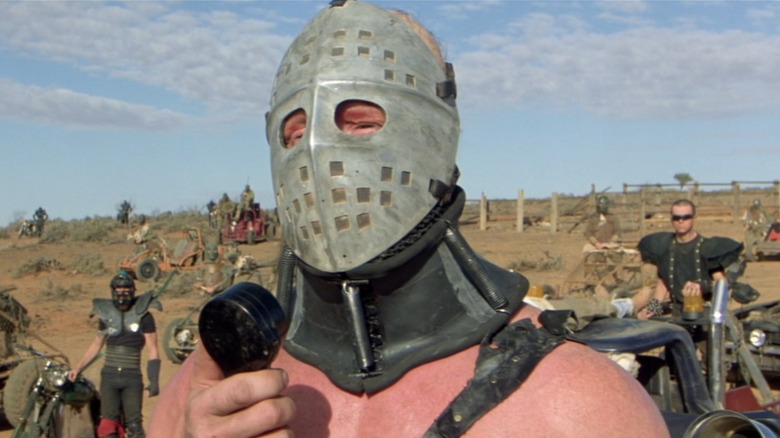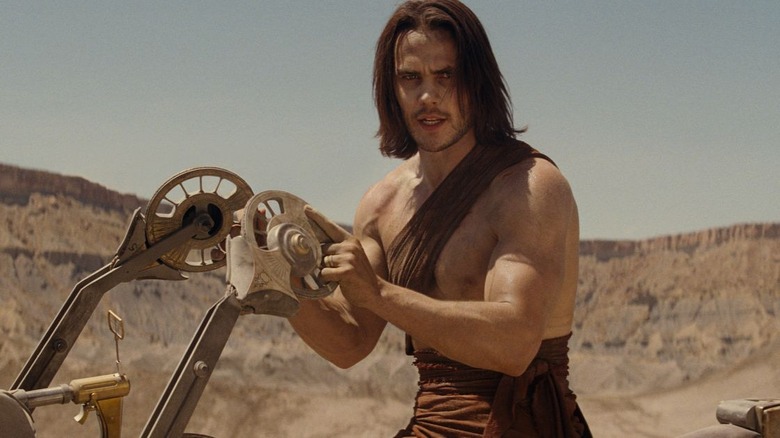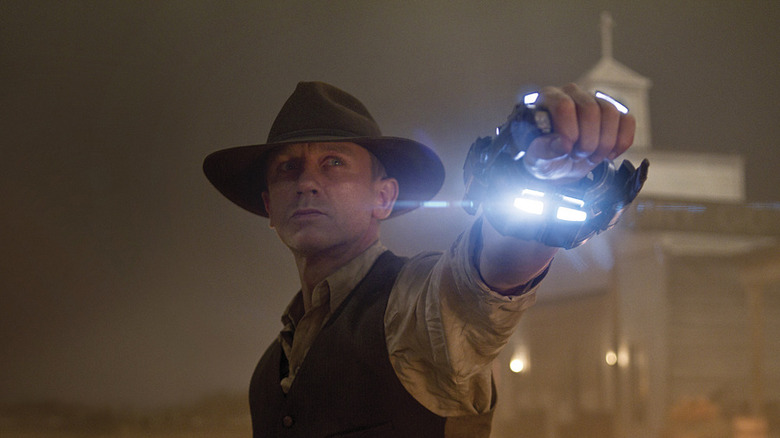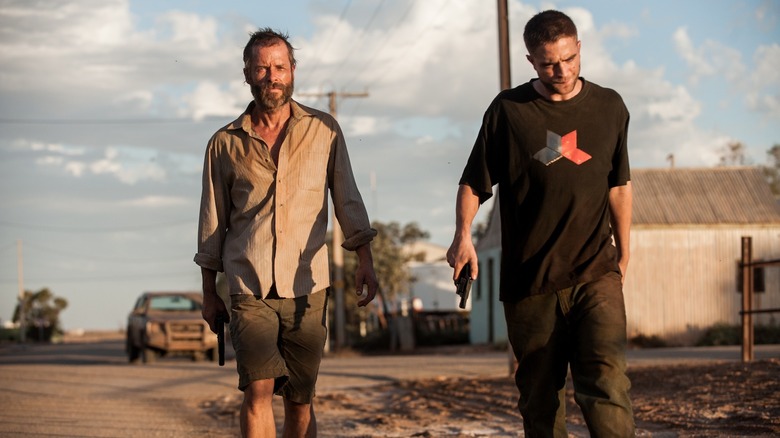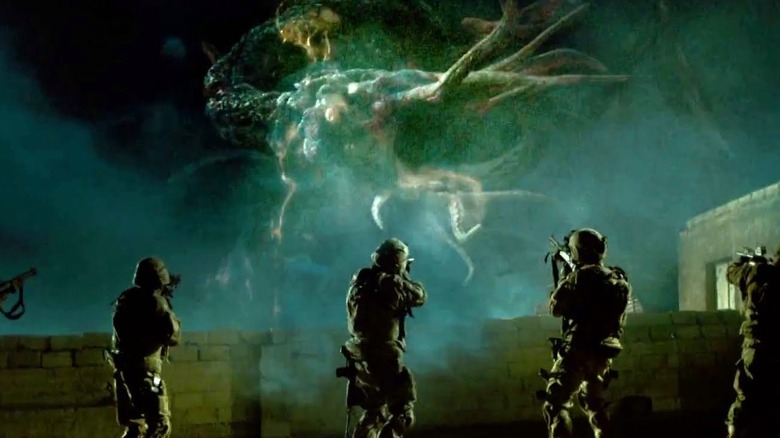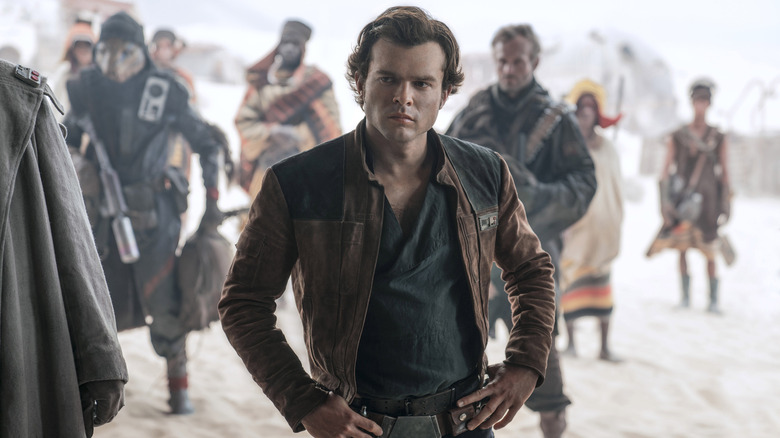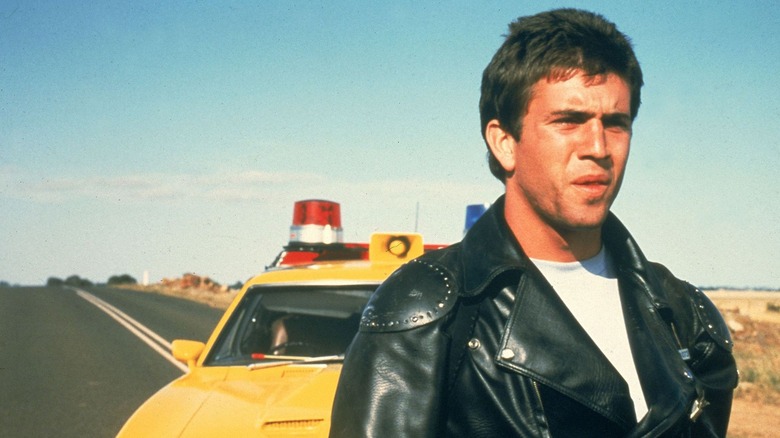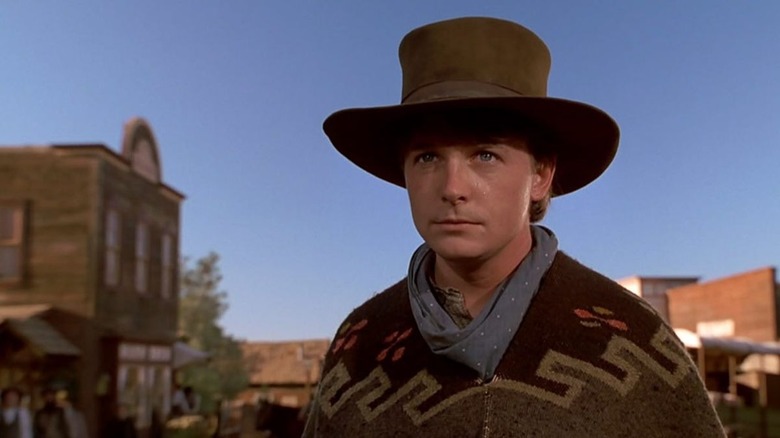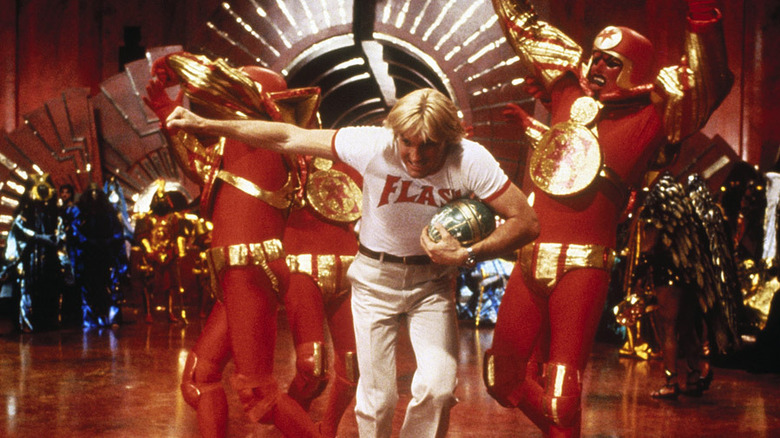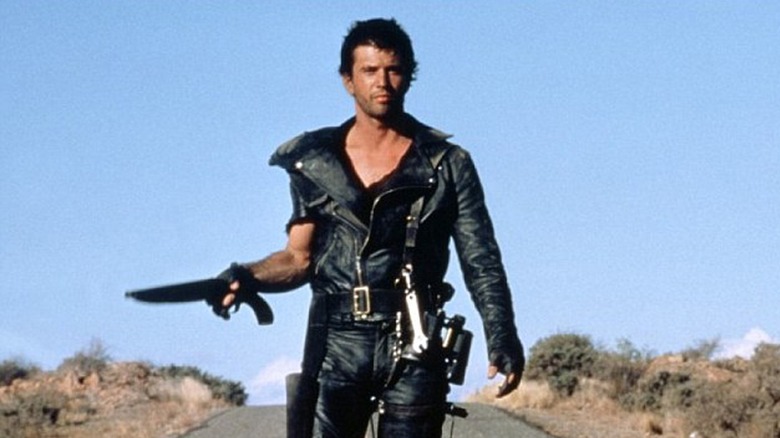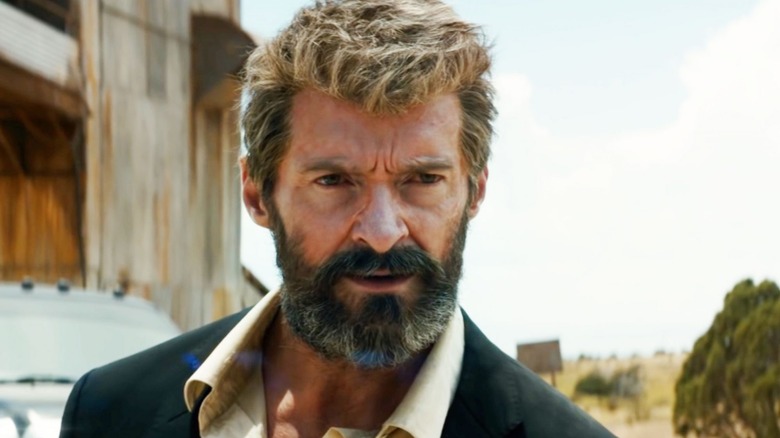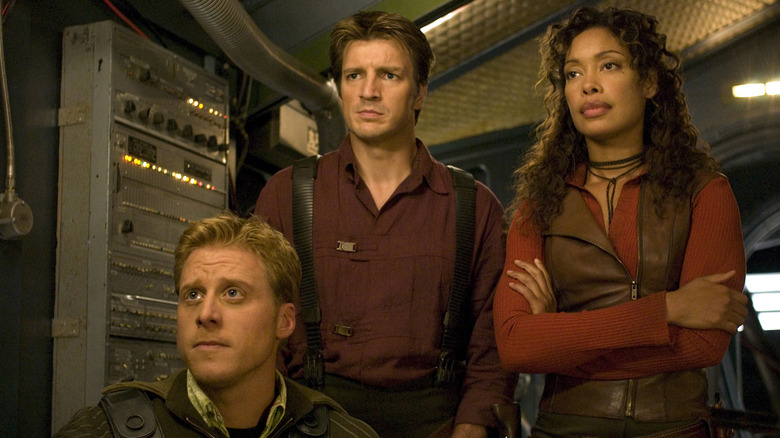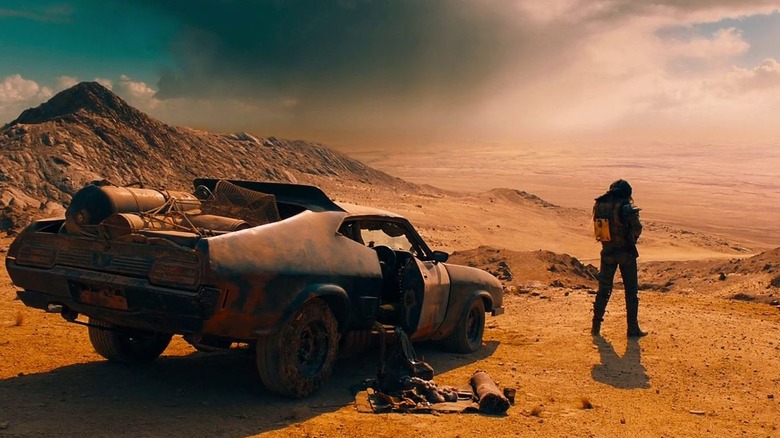The 12 Best Sci-Fi Western Movies Ranked
The western and science fiction genres have always been closely intertwined. Both require signature imagery, exciting action-adventure setpieces, and instantly recognizable heroes and villains; both can be utilized to reflect on larger societal issues. If westerns look at the past from a more nuanced perspective, sci-fi projects explore the future based on the reality that currently exists.
Western heroes were highly influential in the early days of science fiction. There wouldn't be modern sci-fi without the development of the Buck Rogers character, who first debuted in 1928 comic serials before appearing in subsequent serial adaptations, graphic novels, books, stage productions, and feature films. Rogers was a brave gunslinger who explored the furthest reaches of space — quite literally, a space cowboy. The character allowed for the development of more sci-fi heroes like Flash Gordon and Commando Cody, and later influenced Gene Roddenberry's concepts for "Star Trek" and George Lucas' development of "Star Wars."
Some science fiction westerns combine the two genres more directly. Among the most famous is 1973's "Westworld," an adaptation of Michael Crichton's acclaimed novel. The film directly contextualizes western archetypes within a sci-fi premise, as robotic gunslinger androids rebel against their creators in a futuristic theme park. Yul Brenner's terrifying performance as the fearsome gunslinger is synonymous with both genres. The film inspired the acclaimed HBO series of the same name from Jonathan Nolan and Lisa Joy.
Here are the 12 greatest sci-fi western movies, ranked.
12. John Carter
Even before "Buck Rogers," Edgar Rice Burroughs' 1912 novel "A Princess of Mars" was the original sci-fi western adventure. The first in Burroughs' long-running series of Martian adventures introduced the hero John Carter, a former Confederate soldier turned outlaw who avoids the justice of local sheriffs amidst the 1880s. Carter is transported into space through a mystical portal, only to end up employed as a gladiator on Mars for an alien race. It took a century (and years of development hell), but frequent Pixar director Andrew Stanton finally brought "John Carter" to the big screen with his 2012 adaptation.
It's an absolute shame that the film's poor box office performance resulted in the cancellation of a planned trilogy, because "John Carter" is way better than its reputation suggests. It's not just the early sequences set within the Arizona Territory that wear a western influence; seeing Taylor Kitsch's titular outlaw hero inserted into an intergalactic adventure is just as exciting.
11. Cowboys & Aliens
Some sci-fi westerns meld the two genres in subtle ways, but the combination is made crystal clear in a film titled "Cowboys & Aliens." Based on the beloved graphic novel by Scott Mitchell Rosenberg, Jon Favreau's 2011 adaptation is, remarkably enough, not a spoof of either genre. It's surprisingly considerate of how helpless humanity would be to an advanced technological invader, and the limited technology of the Old West makes the characters' plight more challenging. It also subverts westerns with a more sensitive depiction of the relationship between settlers and native indigenous people.
Sullen, amnesiac outlaw Jake Lonergan (Daniel Craig) wakes up in the southern town of Absolution with no memory of his past, and soon discovers a mysterious intergalactic band attached to his arm. Lonergan is brought to the mercy of the powerful local figure Colonel Woodrow Dolarhyde (Harrison Ford), who thinks there could be a connection between the outlaw and the disappearance of his son, Percy (Paul Dano). They join forces to infiltrate a nest of aliens that threaten Absolution.
10. The Rover
The influence of "Mad Max" launched a unique subgenre of dystopian Australian sci-fi westerns, and few imitators of George Miller's style have been able to live up to the heights of his groundbreaking original trilogy. However, David Michod's 2014 thriller "The Rover" is a rare exception (Quentin Tarantino even cited it as the best dystopian western since the original "Mad Max"). The film perfectly combines the hopeless disparity of gritty westerns within a world 10 years removed from a devastating economic collapse.
The film follows the former soldier Eric (Guy Pearce), who lives in isolation within a secluded homestead. Eric's daily life is disrupted when a gang of robbers led by the thug Henry (Scoot McNairy) breaks into his home and steals his car. Eric is unable to stop them, but he does manage to capture Henry's mentally-disabled brother Reynolds (Robert Pattinson). Eric and Reynolds form an uneasy alliance in order to track down the other criminals, and both try to influence each others' actions. Pearce has rarely been more devastating onscreen, and the film showcases one of Pattinson's best post-"Twilight" roles.
9. Monsters
Westerns are often compelling because their environments are pre-established. There's not much detail required to explain that a story is set within the Old West, and as a result, the narrative can take place pretty much anywhere. Even if it's traditionally thought of as an American genre, Australian and Italian westerns are an integral part of the genre's history. Gareth Edwards explored this idea with his 2010 sci-fi western "Monsters;" there's little exposition explaining the post-apocalyptic premise, as the audience only learns about the mythology through the interactions between the characters.
"Monsters" follows cynical photojournalist Andrew Kaulder (Scoot McNairy), who remains reclusive as he copes with a personal tragedy. Kaulder is recruited by his boss to embark on a dangerous cross-country mission to find his daughter, Samantha Wynden (Whitney Able). Samantha is trapped behind the Mexican border (a popular setting within westerns) and needs to be covertly brought to safety in the United States. The sci-fi elements are only gradually introduced during Kaulder's travels, as he must avoid extraterrestrial creatures that landed on Earth after the crash of a NASA ship in the desert.
Westerns often explore the starkness of the natural world, and "Monsters" shows the events of the post-apocalypse away from anything catastrophic. The limited exposure to the outside world allows Edwards to focus on the relationship between Kaulder and Samantha. Kaluder is initially not forthcoming, but he gradually opens up to his new companion and explains his tragic history.
8. Solo: A Star Wars Story
It's no secret that the "Star Wars" franchise popularized the space western. The notion of smugglers, bounty hunters, seedy bars, and run-down technology was fun to see combined with the sci-fi and fantasy elements, and the series has only continued to lean further into space western territory with the live-action Disney+ series "The Mandalorian" (which is heavily inspired by Sergio Leone's "The Man With No Name" trilogy).
When the "Star Wars" franchise was relaunched under Disney, Kathleen Kennedy decided that the spin-off anthology films would be straight-up genre vehicles. Without the burden of continuing the mythological roots of the Skywalker saga, 2016's "Rogue One: A Star Wars Story" became a war film, while 2018's "Solo: A Star Wars Story" reverted to the series' western origins. It explores the "hive of scum and villainy" within the franchise's criminal underbelly, and here the stakes are not centered around the fate of the galaxy. Rather, the film focuses its attention on a relatively small-scale heist story about competing criminal gangs that double-cross each other.
Alden Ehrenreich gives a terrific performance as the titular young smuggler, quite unlike the world-weary cynic Harrison Ford essayed years prior. "Solo" also reimagines western archetypes, like the mob boss Dryden Vos (Paul Bettany) and the shady double-crosser Tobias Beckett (Woody Harrelson).
7. Mad Max
George Miller's "Mad Max" series is the definitive sci-fi western franchise. The later films explored a gritty, run-down, post-apocalyptic future where mankind had been reverted to a chaotic Old West state, but the original 1979 film was pivotal in showing how the depletion of infrastructure began. The film chronicles the societal collapse through the eyes of the police officer Max Rockatansky (Mel Gibson), who only gradually becomes "Mad" as the story continues.
Compared to the subsequent installments, which are more action-packed and over-the-top, "Mad Max" is a relatively low-key character drama. Max pursues the dangerous motorcycle biker Crawford "Nightrider" Montazano (Vincent Gil) after he kills one of his friends on the police force, but Nightrider's allies Toecutter (Hugh Keays-Byrne) and Bubba Zanetti (Geoff Parry) begin wreaking havoc throughout the city. It was Keays-Byrne's first collaboration with Miller, and he would later return to the series to play the main villain Immortan Joe in "Mad Max: Fury Road."
"Mad Max" explores the tragedy that sets the events of the franchise into motion. Max loses his wife Jessie Rockatansky (Joanne Samuel), and becomes hardened and skeptical about humanity's future. Many western heroes have traumatic origin stories, and Miller showed the sympathetic place in which these heroes earn their names. Max would become as crazy as the world that surrounded him by the time "The Road Warrior" rolled around, but here we get to see Max at his most lawful and relatable.
6. Back to the Future: Part III
Not every science fiction franchise is inherently inspired by westerns, and "Back to the Future" certainly wasn't. Marty McFly (Michael J. Fox) isn't a gunslinging outlaw or a sheriff, but an average teenager. Robert Zemeckis' 1985 original explored the ongoing developments within technology and science, and utilized a premise that was closer to that of classic screwball comedies. 1989's "Back to the Future: Part II" took the series in a dystopian direction when Marty travels to a dark vision of the future where his parents don't end up together, and the ending teased another genre mashup for the series' third at-bat: Marty must travel even further back in time, to the Old West, in order to rescue his best friend, scientist Doc Brown (Christopher Lloyd).
"Back to the Future: Part III" is a delightful tribute to classic westerns. Marty even dons the persona of "Clint Eastwood" at one point, in dedication to his favorite western actor. Having a character who's aware of western cinema archetypes makes the story more engaging, and adds plenty of humor, as well. However, the western elements are still well handled, and in particular the villainous Buford "Mad Dog" Tannen (Thomas F. Wilson) makes for a fearsome, no-nonsense gunslinger.
Sci-fi westerns are interesting when they combine iconography, and "Back to the Future: Part III" includes steampunk elements. Doc is without the Delorean, so he must create new time travel devices utilizing the limited technology of the time period in which he has become trapped.
5. Flash Gordon
The original Flash Gordon character was introduced shortly after Buck Rogers, and was designed to directly compete with that iconic space cowboy. First appearing in comic strips in the mid-'30s, Flash Gordon was a similar cosmic adventurer with the same nobility and combat skills as a classic western hero. He would later appear in countless comic books, radio plays, serials, television shows, and cartoons, and filmmakers had tried for generations to adapt the character for the big screen. George Lucas, who had loved the character growing up, attempted to purchase the rights to an adaptation in the 1970s. When he was turned down by producers, he simply made "Star Wars" instead.
"Flash Gordon" finally made his way to the big screen in 1980, in a film directed by Mike Hodges. Hodges told the origin story of the titular New York Jets football star (Sam J. Jones) who is transported from Earth into the vast reaches of space. Flash is gifted with superhuman powers by the brilliant scientist Dr. Hans Zarkov (Topol), but he's captured by the intergalactic supervillain Ming the Merciless (Max von Sydow). Flash gathers his allies to lead a revolution against the wicked dictator.
"Flash Gordon" is gleefully campy and doesn't attempt to modernize the original serials. The depiction of good and evil is completely earnest, although there are self-aware nods to the character's history. It's the perfect translation of one of the original sci-fi westerns.
4. Mad Max 2: The Road Warrior
While 1979's "Mad Max" was a brilliant film, its audience was mostly limited to Australian viewers and wasn't as popular in the United States. The 1981 sequel was therefore marketed simply as "The Road Warrior," and some viewers weren't even aware of the connection to George Miller's original film. The story is essentially a standalone; like classic western heroes, "Mad" Max Rockatansky (Mel Gibson) goes on adventures that can basically be viewed as an anthology. "Mad Max 2: The Road Warrior" leaned even heavier into the western influences than its predecessor had, and as a result, it's one of the greatest sequels ever made.
While "Mad Max" explores how humanity falls into a post-apocalyptic state, "The Road Warrior" is set within a brutal desert where the world is already without hope. Like any classic western hero, Max is a drifter who prizes his own survival first — any noble intentions are secondary to staying alive amidst the brutal environment. Max has abandoned his career in law enforcement, but is hunted by a gang of violent bikers led by Lord Humungus (Kjell Nilsson). However, he gradually accepts the pursuit of justice when the gang threatens a small village, the same plight that many classic gunfighters faced in the Old West.
George Miller is a genius at creating memorable action sequences, and he crafts thrilling chase sequences as Max battles the evil goons. Max's relationship with the young Feral Child (Emil Minty) gives the film its heart without being schmaltzy.
3. Logan
The "X-Men" franchise expertly mixes genres to create stories that tend to feel unique amidst the typical superhero content in popular media. While the films ably translate the heroic depictions of the original Marvel comics, they also incorporate elements of fantasy, coming-of-age, comedy, and political satire. The franchise went in many different directions, but the solo films focused on Wolverine (Hugh Jackman) tended to pinpoint his isolation and inability to find inner peace. 2009's "X-Men Origins: Wolverine" was an awkward blend of convoluted world-building, but James Mangold's more serious 2013 film "The Wolverine" inserted the character within a Samurai epic that felt closer in tone to the films of Akira Kurosowa than a traditional superhero story.
Mangold experimented with genres once more in 2017 with "Logan," a film so indebted to its western influences that it even includes clips from the 1953 Alan Ladd classic "Shane." Compared to the time-travel and world devastating events of the previous films, "Logan" tells a stripped-down story of Wolverine living within the outskirts of Texas. Asserting that stories of the "X-Men" are wildly exaggerated, Wolverine cares for the dying Professor Charles Xavier (Patrick Stewart) and doesn't intend to go on any more adventures. He's reluctantly called back into action when he discovers the young mutant girl Laura (Dafne Keen), who seeks his protection.
Placing Wolverine within a western was a brilliant choice, as it made his final screen appearance more emotional, and the R-Rating allowed Mangold to show the west with full brutality.
2. Serenity
Joss Whedon's beloved science fiction western adventure series "Firefly" provided viewers with exciting stories exploring the vastness of outer space in a way that was similar to the Old West. Captain Malcolm Reynolds (Nathan Fillion) was a rough and tough gunslinger, fitting the classic western archetype of a former veteran who is haunted by his wartime experience and forced into a shady line of work. Reynolds led his crew of beloved characters, including his wartime ally Zoë Alleyne Washburne (Gina Torres), the wisecracking pilot Hoban Wash (Alan Tudyk), the humorous mercenary Jayne Cobb (Adam Baldwin), personal escort Inara Serra (Morena Baccarin), quirky mechanic Kaylee Frye (Jewel Staite), wise preacher Shepard Book (Ron Glass), and new recruits Simon (Sean Maher) and River Tam (Summer Glau). The crew leads smuggling missions across the galaxy, and against Reynolds' better judgment they're called into acts of heroism.
"Firefly" was unfortunately canceled after its first season, leaving fans with only 14 episodes and no proper conclusion. Thankfully, Whedon was able to conclude the storylines planned for subsequent seasons with his 2005 film "Serenity." The film reunited the original cast for a new adventure where they're stalked by a mysterious assassin employed by the totalitarian government military force the Alliance, known simply as "The Operative" (Chiwetel Ejiofor). The Operative fits within the mold of a classic western antagonist — he's bound by duty, even stating that he's a "necessary evil" that the Alliance needs. Ejiofor fleshes out the archetype by showing The Operative's sympathetic side.
1. Mad Max: Fury Road
Three decades after the conclusion of the original trilogy, there were significant expectations for George Miller's fourth entry in the "Mad Max" franchise. The first two films masterfully incorporated the science fiction post-apocalyptic elements within the concept of an Australian western, but "Mad Max: Fury Road" surpassed every expectation. It explored classic western themes of an isolated society, a former law enforcement officer returning to nobility, and heist caper elements within all of its glorious, madcap action.
Tom Hardy stepped into the titular role that Gibson had made iconic, and though his grizzled bluntness fit the role perfectly, Hardy was outshined by the new protagonist Furiosa (Charlize Theron). An imperator for the warlord Immortan Joe, Furiosa rebels against her vicious boss and rescues his female breeders. Westerns are effective when they challenge traditional notions of masculinity, and having the female characters be featured so prominently here was integral.
"Mad Max: Fury Road" isn't just the best action movie since "Die Hard," but a great western. The stark imagery of the isolating desert and eccentric rogue's gallery feel lifted from the classics of western cinema, particularly with Immortan Joe's control of resources and water. Max fits the mold of a lonely gunslinger; he doesn't have a personal stake in the conflict, but he's called into acts of heroism nonetheless. Furiosa became the defining hero of a generation regardless of genre (don't worry, she'll be back).
